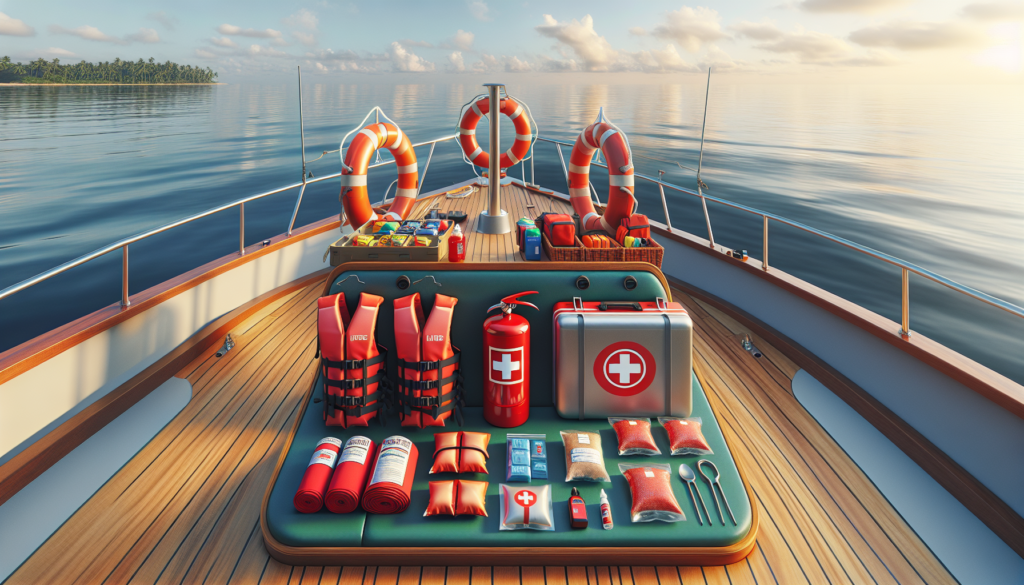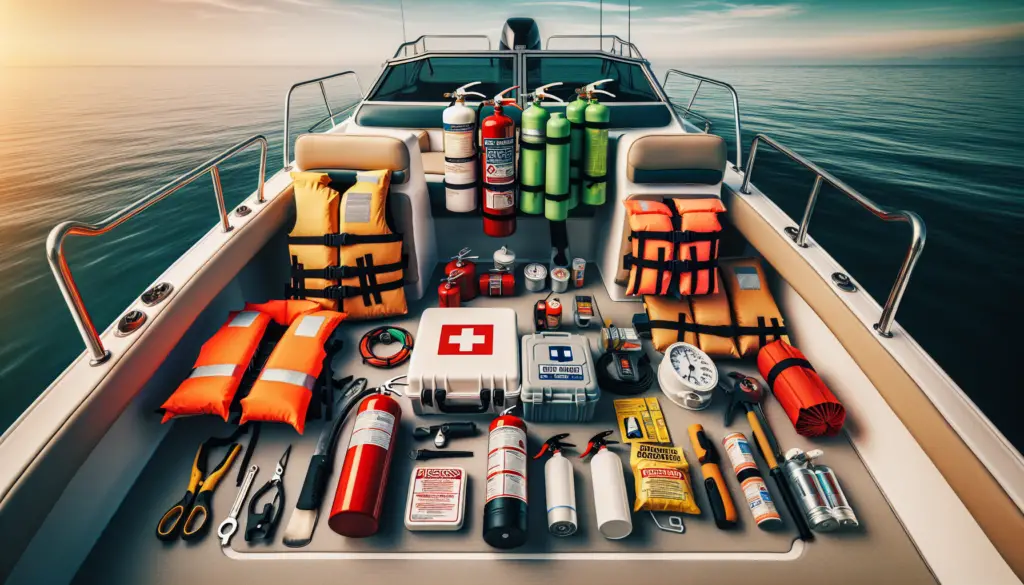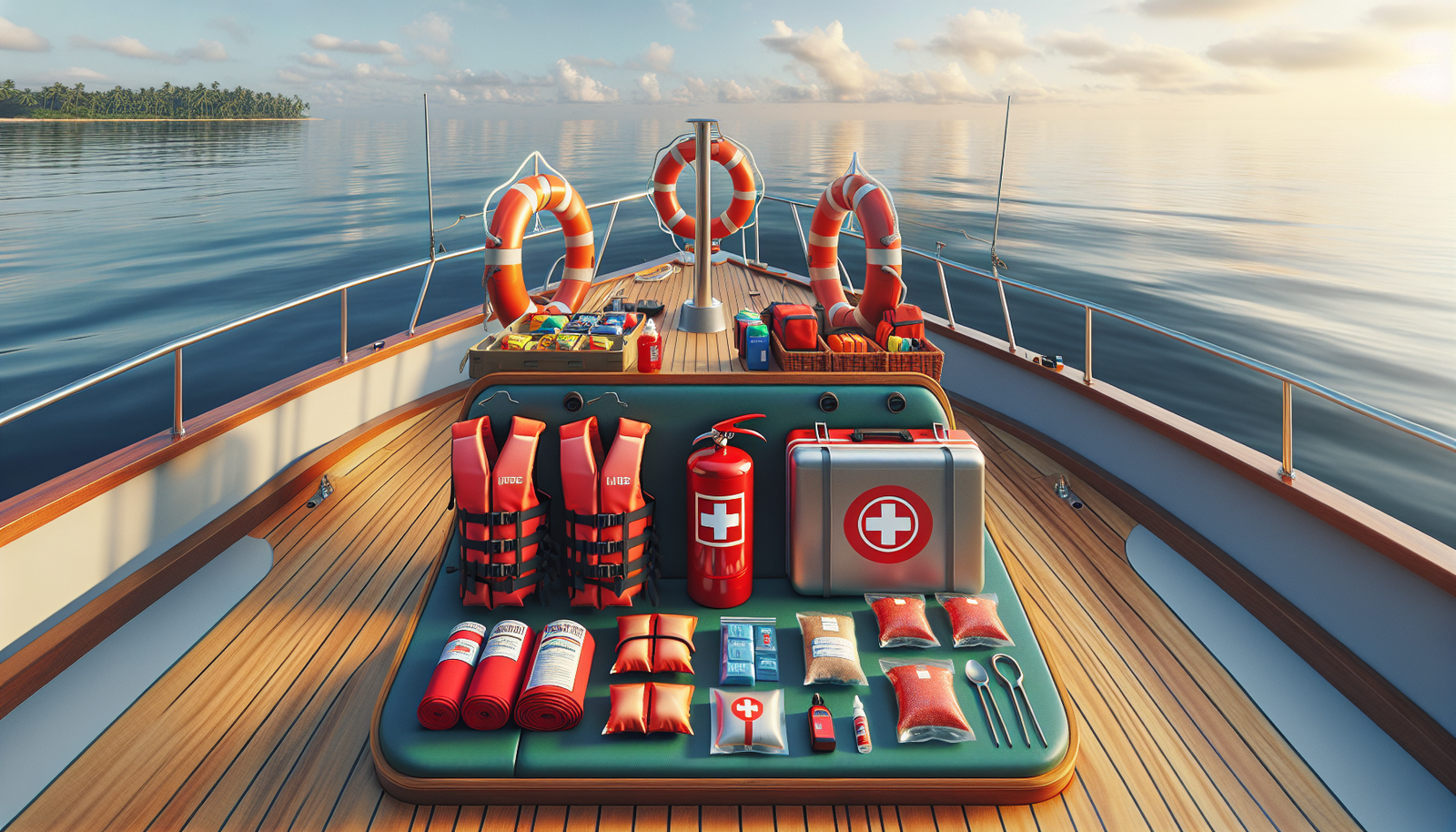You’re getting ready for a fun-filled day on the water, but before you cast off, there’s a checklist to run through. Your boat is more than just a means of recreational leisure; it’s a vessel that requires adequate safety precautions. This piece explores the essential safety equipment required for recreational boating, from life vests to flares and everything in between. It’s not just about staying afloat; it’s about being prepared for any curveballs the vast waters may throw your way. Now, let’s ensure you are geared up for a safe seafaring adventure.

Personal Flotation Devices (PFDs)
Personal flotation devices, popularly known as PFDs, are a critical part of boat safety equipment.
Importance of PFDs
These lifesavers come in handy when you or any of the boat crew accidentally fall overboard or need extra support to stay afloat in the water. PFDs provide buoyancy that can notably increase your survival chances, especially in deep waters or rough seas. They are simple to use, ensuring your head stays above water, reducing the risk of drowning. It’s paramount that you have enough PFDs on your boat for each person on board.
Types of PFDs
There are several types of PFDs to choose from, and these include life jackets, buoyancy aids, Throwable PFDs, and special use PFDs. The most appropriate type hinges on the type of water activity, weather conditions, and the user’s swimming skills.
Factors to Consider When Choosing PFDs
When choosing PFDs, you need to consider several factors such as the device’s buoyancy level, fit, and comfort. Remember, a PFD should fit snugly but without restricting movement. Also, it should be in a color easily visible in water.
Distress Signals
When on a boat, you must always be prepared for unexpected situations. One of the essential safety equipment you can have on board is a distress signal.
Usage of Distress Signals
In an emergency, you can use distress signals to signal for help. These signals are a reliable way of drawing attention and indicating that you are in imminent danger. Whether at day or night, these tools are designed to maximise visibility or audibility making it simple for rescue teams to locate and assist you.
Types of Distress Signals
There are different types of distress signals including flares, EPIRBs (Emergency Position Indicating Radio Beacon), SOS lights, VHF radio distress signals, and even simple things like waving a flag or blowing a whistle.
How to Properly Store and Maintain Distress Signals
Store distress signals in a dry, accessible place, away from children’s reach. Read the manual to understand how to use them and their expiration dates. Discard expired signals and replace them promptly.
Fire Extinguishers
Fire extinguishers are perhaps a less obvious type of safety equipment for boating enthusiasts, but they’re just as essential.
The Need for Fire Extinguishers in Recreational Boats
A small spark can ignite a devastating fire on a boat, primarily if it’s fueled by gasoline or propane. Fire extinguishers can control small fires before they spread and become unmanageable.
Different Types of Fire Extinguishers
Portable fire extinguishers designed for use on boats are typically classified as B-I and B-II, depending on their capacity. The selection of a fire extinguisher depends on the size of your boat.
How to Use a Fire Extinguisher
When using a fire extinguisher, remember the acronym PASS: Pull the pin, Aim at the base of the fire, Squeeze the trigger, and Sweep from side to side. Ensure all boat passengers know this procedure.
First Aid Kit
A reliable first aid kit is an absolute must-have for any boating activity.
Purpose of a First Aid Kit
Boating can come with its fair share of minor accidents and injuries. Having a first aid kit on board can help manage these injuries before professional medical help can be sought.
What to Include in a Boat First Aid Kit
Your kit should include essentials such as bandages, antiseptic wipes, tweezers, medical tape, motion sickness tablets and a manual. The contents can vary based on your needs and where you’ll be boating.
Using a First Aid Kit in Common Boat-related Injuries
First aid can include cleaning and bandaging a wound, performing CPR, treating burns, or even stabilizing fractures. Quick and appropriate responses can save lives.

Navigation Equipment
Proper navigation is a crucial aspect of boating safety.
Importance of Navigation Equipment
Without the right navigation tools, you could easily get lost at sea. These tools will ensure you maintain the right path and help you avoid dangerous areas.
Essential Navigation Tools
The essential navigation tools include a compass, charts, GPS system, and depth finder. Learn how to use these tools even if your boat has an electronic system.
Maintaining and Using Navigation Equipment
Monitor your navigation equipment for any faults or discrepancies and get them fixed immediately. Always carry backups and understand their manual operation.
Communication Devices and Radios
Communication devices and radios are indispensable for safe boating.
Communicating in Case of Emergencies
You never know when an emergency might strike your boat. Communication devices help you reach out to nearby boats, the coast guard or emergency services.
Types of Communication Devices
Marine radios, satellite phones, mobile phones, and personal locator beacons are effective communication devices. Marine radios are the most common and versatile.
Effective Use of Marine Radios
In addition to calling for help, marine radios can be used for weather updates and communication with marina staff or other boats. It’s important to understand marine radio etiquette and distress procedures.
Sound Producing Devices
Sound producing devices are a vital part of your safety tools.
Why Sound Producing Devices are Essential
Whistles, horns, or bells are often used to signal other boats, especially when visibility is poor due to fog or darkness.
Types of Sound Producing Devices
Sound devices vary from traditional bells and whistles to air horns and electric sound producing devices. Choose a device based on your boating needs.
Use of Sound Producing Devices in Different Situations
Effective use of sound producing devices can help prevent collisions, signal distress, or communicate maneuvers.
Life Rafts
In extreme situations where the boat is no longer safe, a life raft becomes an invaluable piece of survival gear.
When a Life Raft is Necessary
When your boat capsizes, catches fire, or sinks, a life raft could be your primary survival tool.
Choosing the Right Life Raft
The right raft depends on the size of your crew, type of boating activity, and storage space available on the boat.
Storage and Maintenance of Life Rafts
Store the life raft in an easily accessible place. It needs regular inspection and servicing to ensure it inflates properly when needed.
Auxiliary Propulsion
A reliable auxiliary propulsion system is crucial for every boat.
Understanding Auxiliary Propulsion
These are alternative propulsion systems, like a secondary engine or sails, that can be used if the main engine fails.
Considerations when Selecting Auxiliary Propulsion
Primary considerations include the size of the boat, main propulsion system, and typical sea conditions.
Proper Use and Maintenance of Auxiliary Propulsion Devices
Regularly check the functioning and condition of the device to assure readiness in case of an emergency.
Safety Harnesses and Lines
Safety harnesses are often overlooked but they are vital for safety, particularly during rough weather.
Purpose of Safety Harnesses on a Boat
A safety harness keeps you securely attached to the boat, preventing you from getting swept overboard.
Selecting the Right Safety Harness
Choose a harness that is sturdy, comfortable, and easy to wear and adjust and with strong fastenings.
Appropriate Use of Safety Harnesses and Lines
Always wear a safety harness when moving around the boat during rough seas or poor visibility. Regularly inspect and replace worn-out hooks and lines.
In conclusion, all the safety equipment mentioned above is crucial for safe and enjoyable recreational boating. Always remember that safety should be your top priority.

